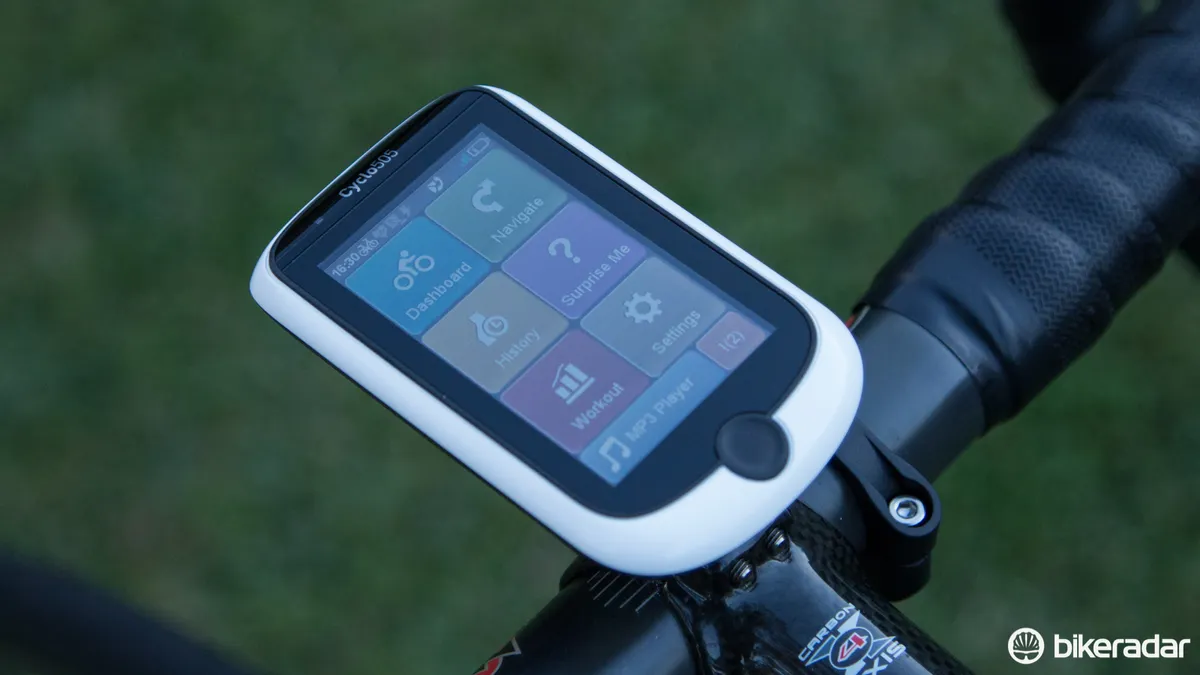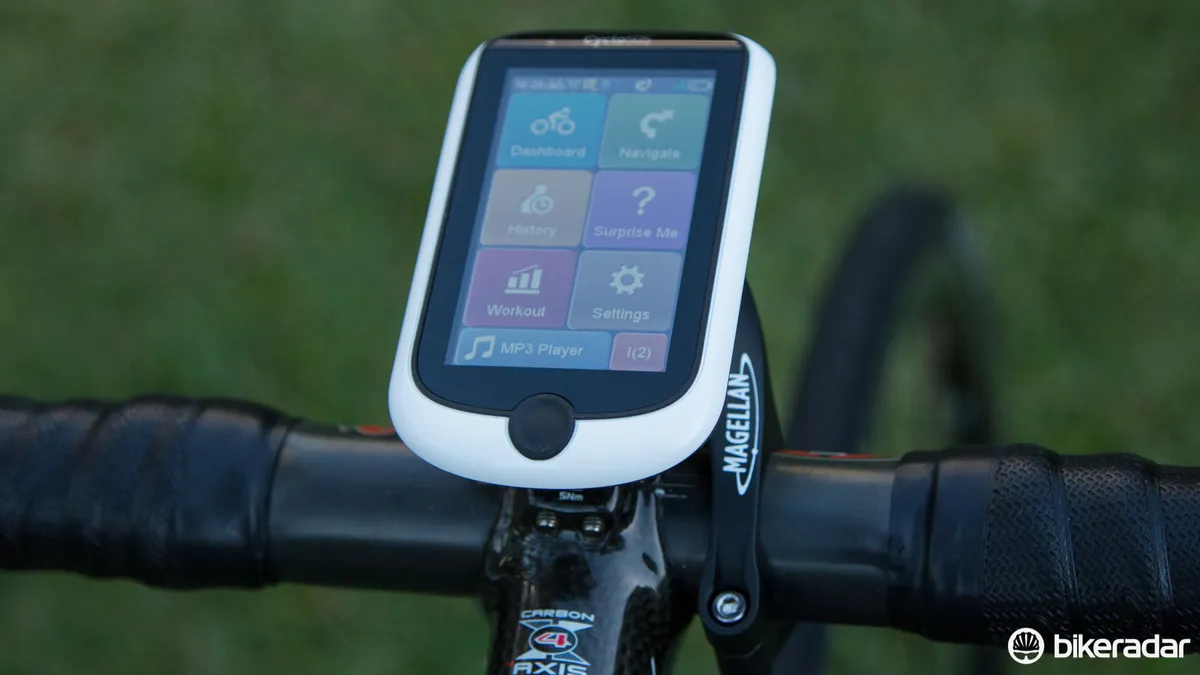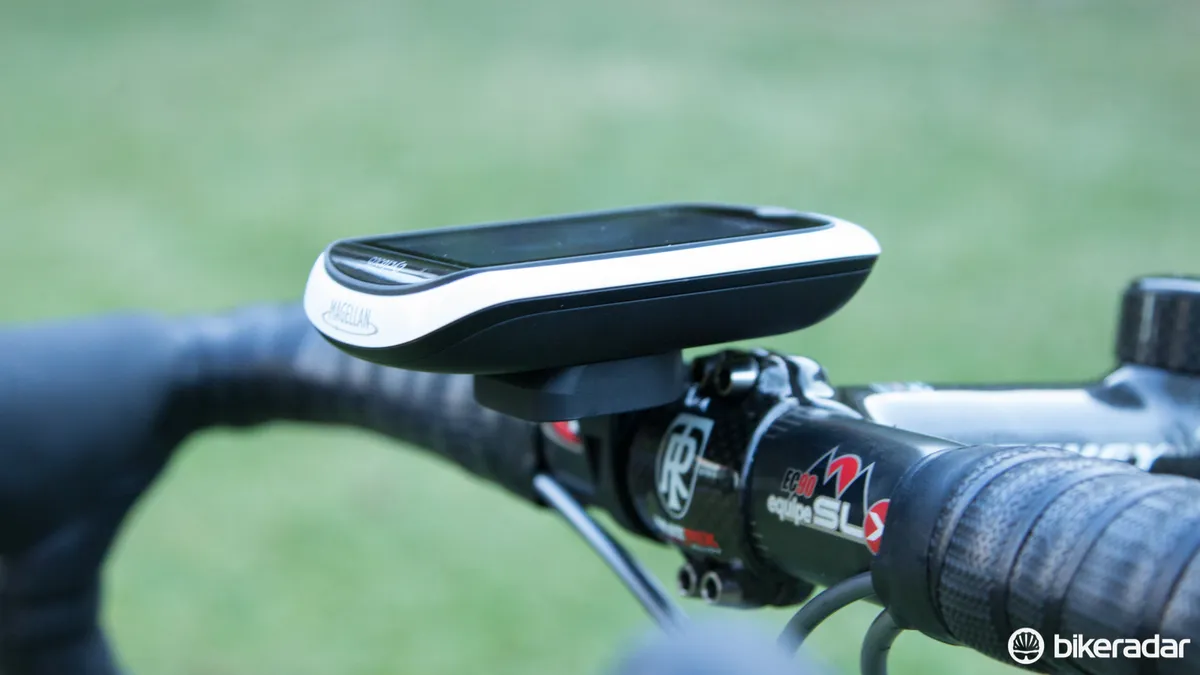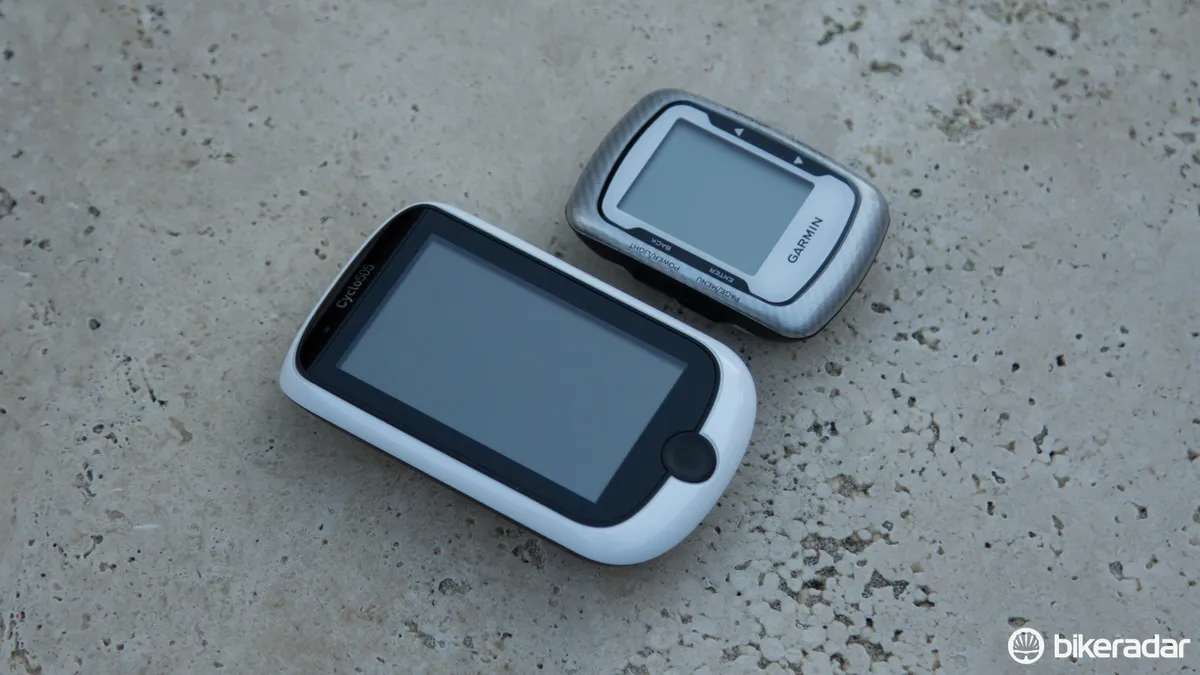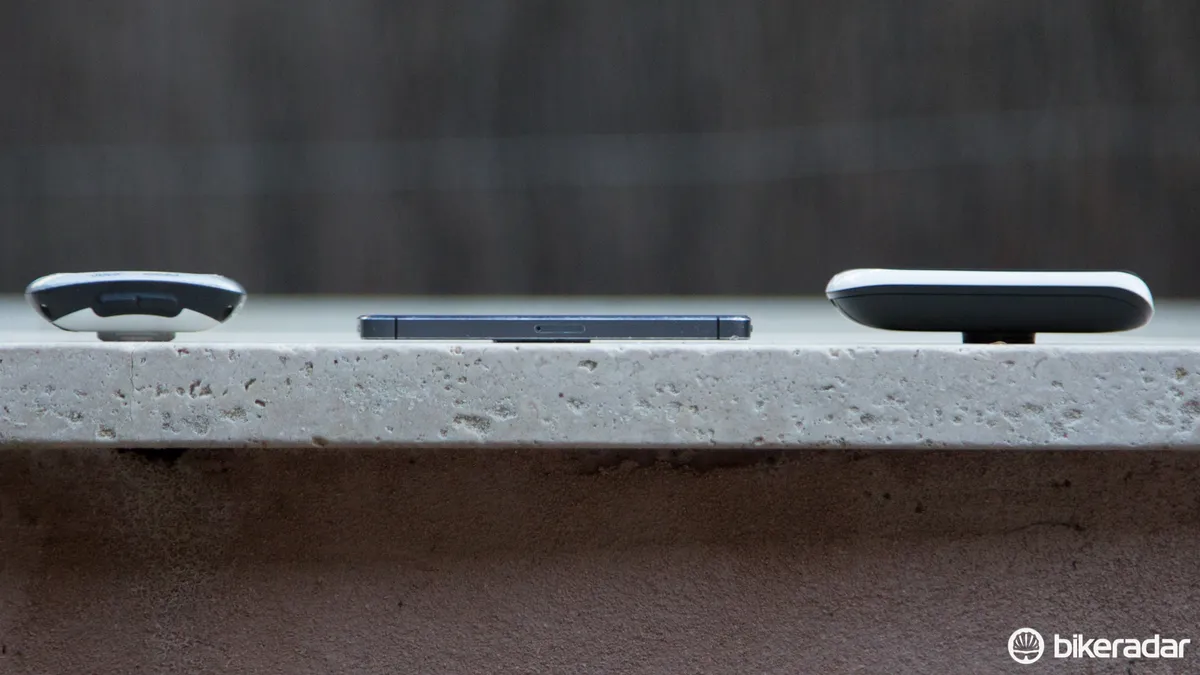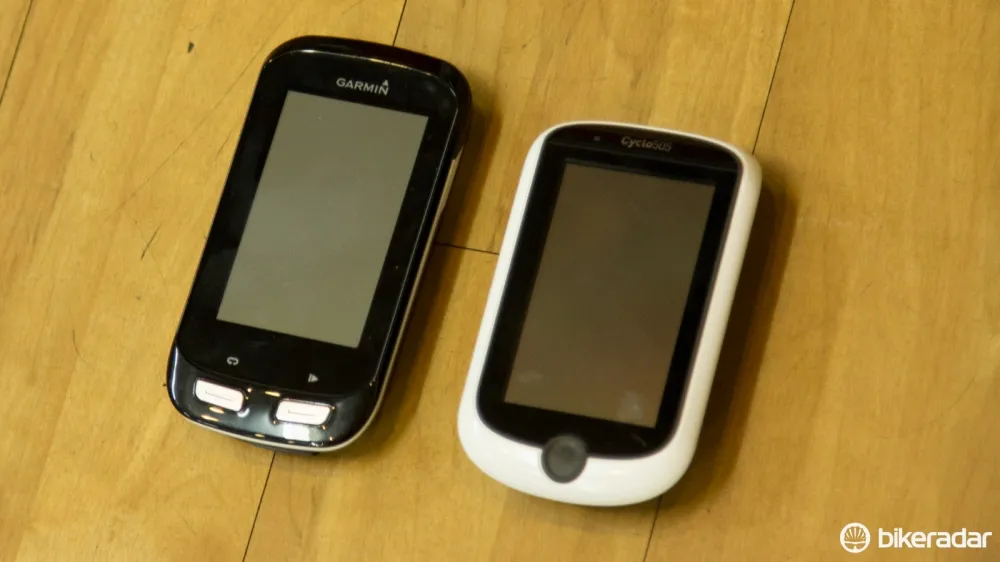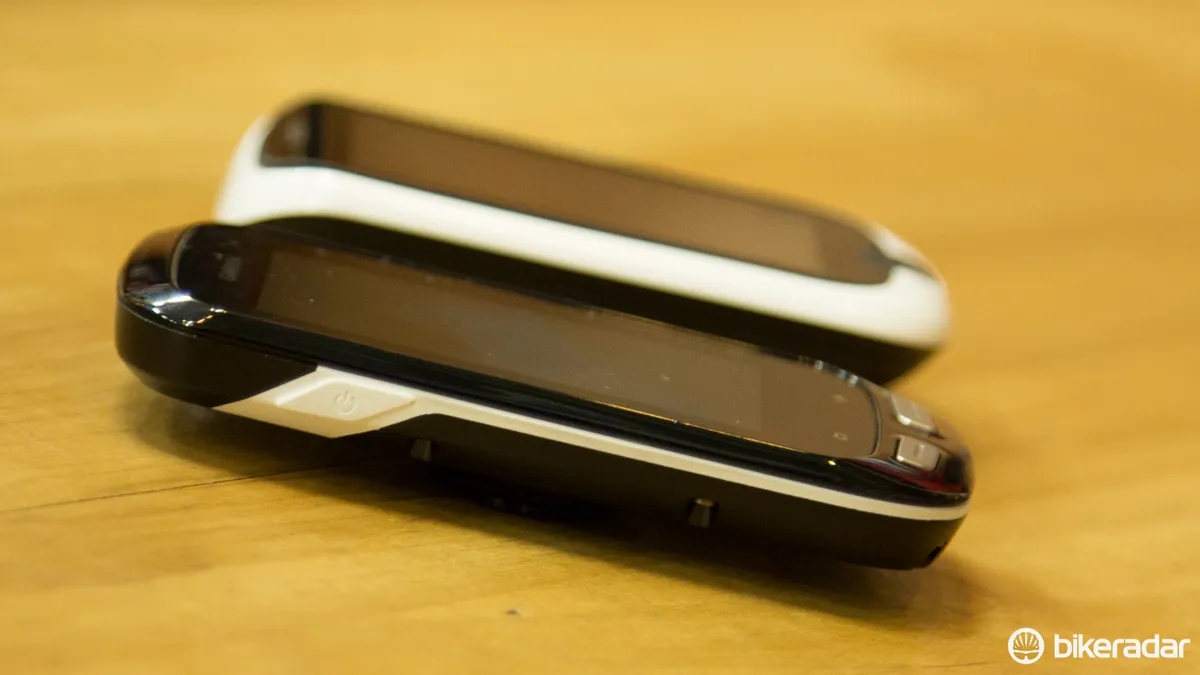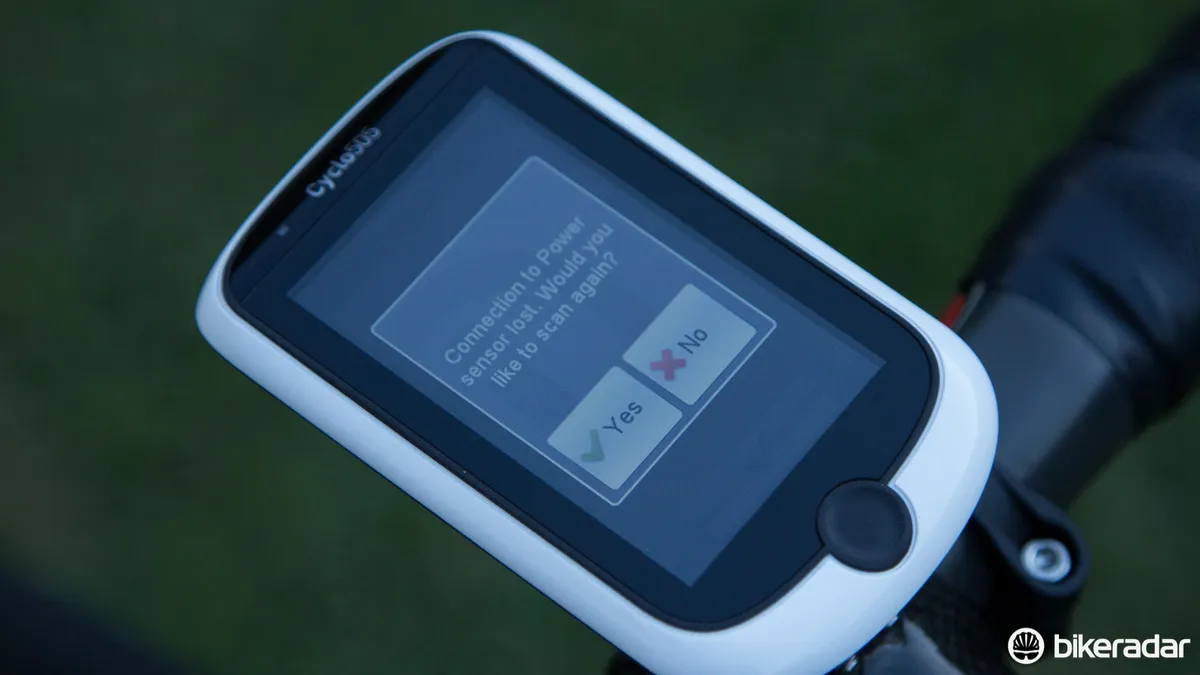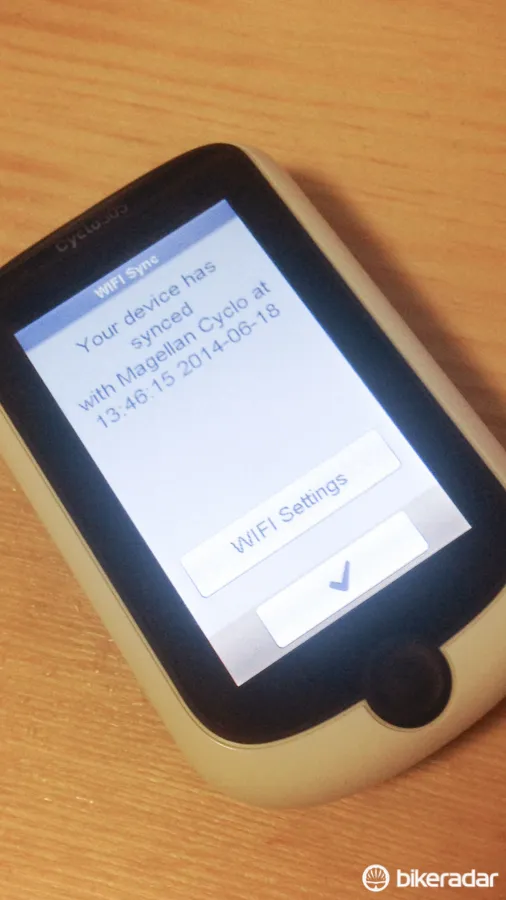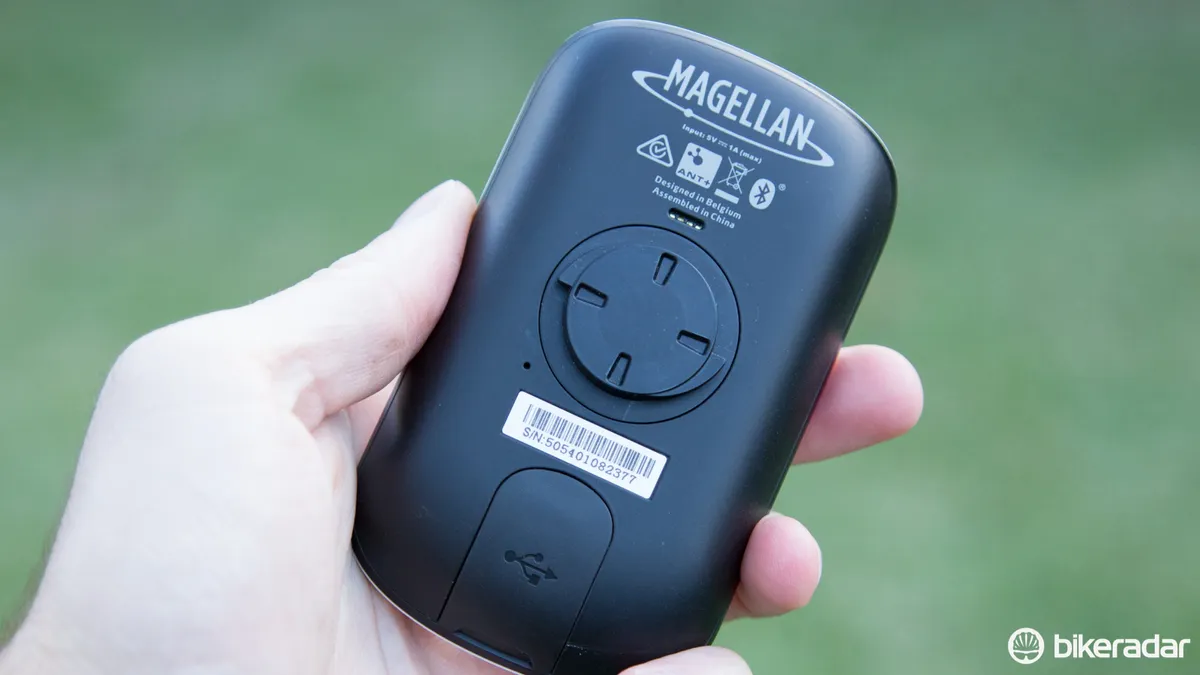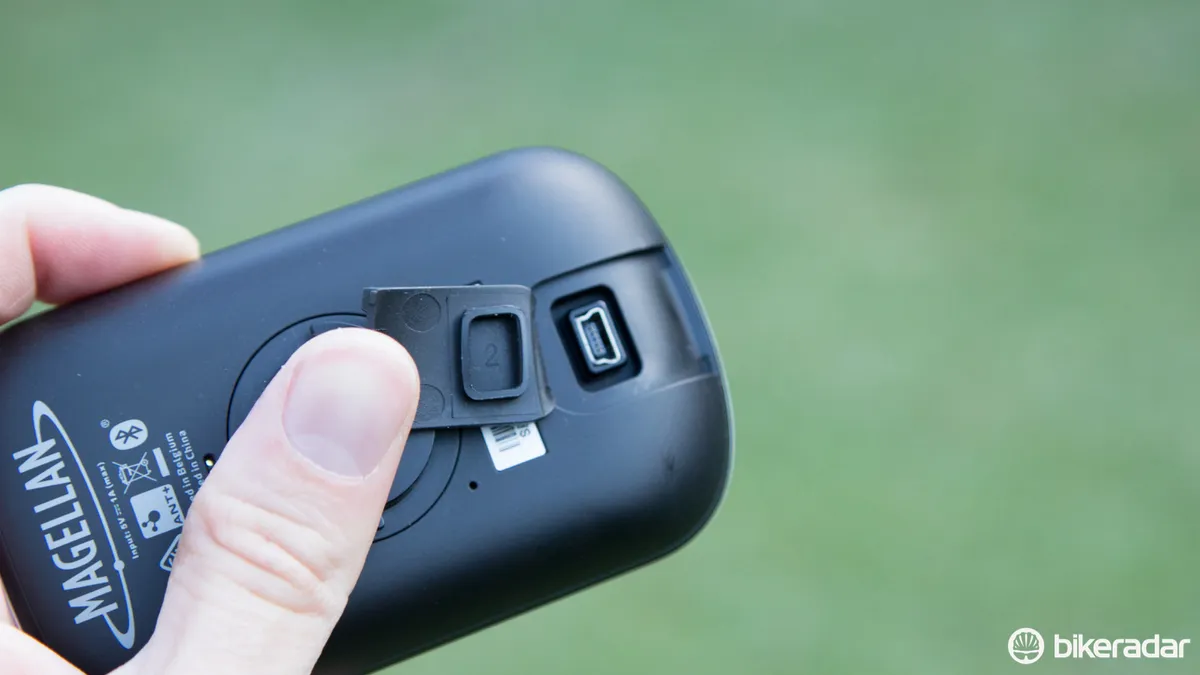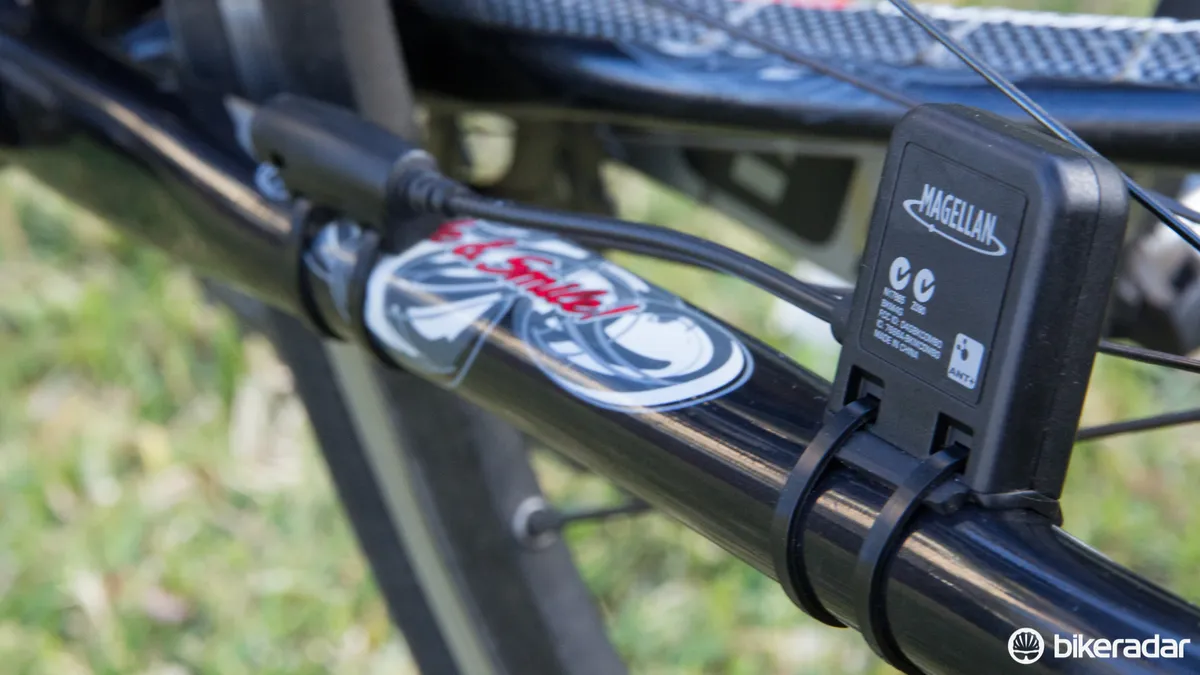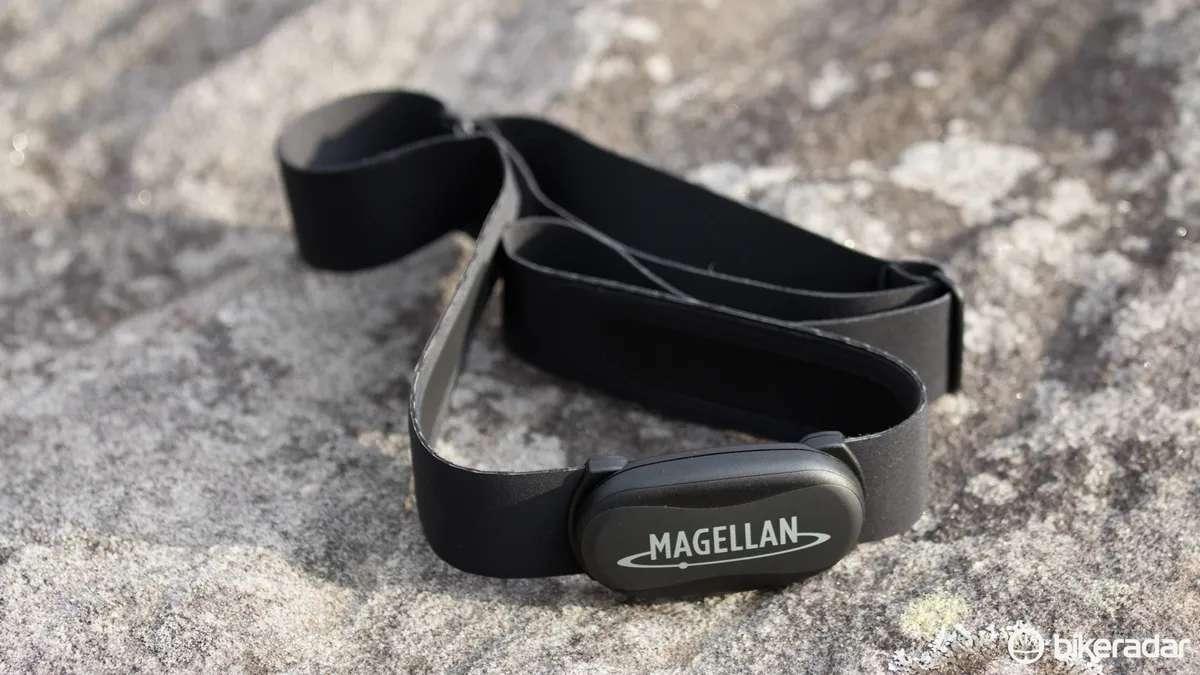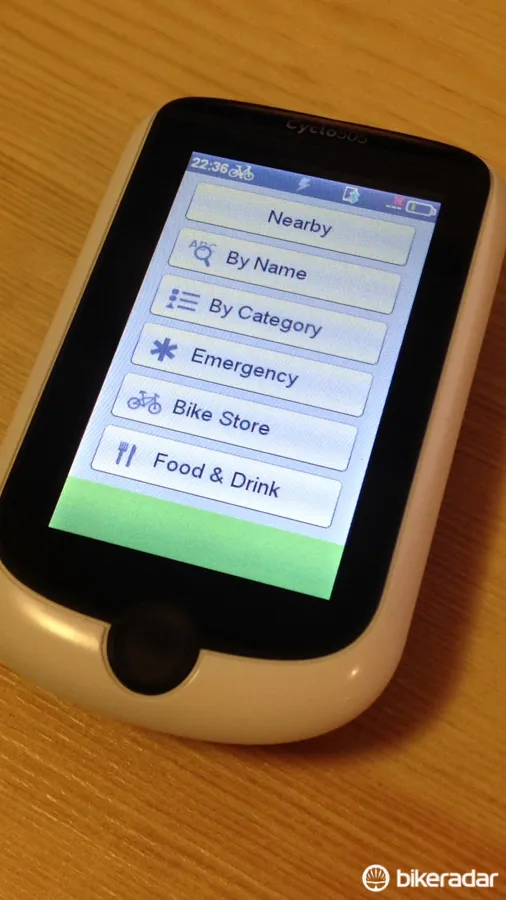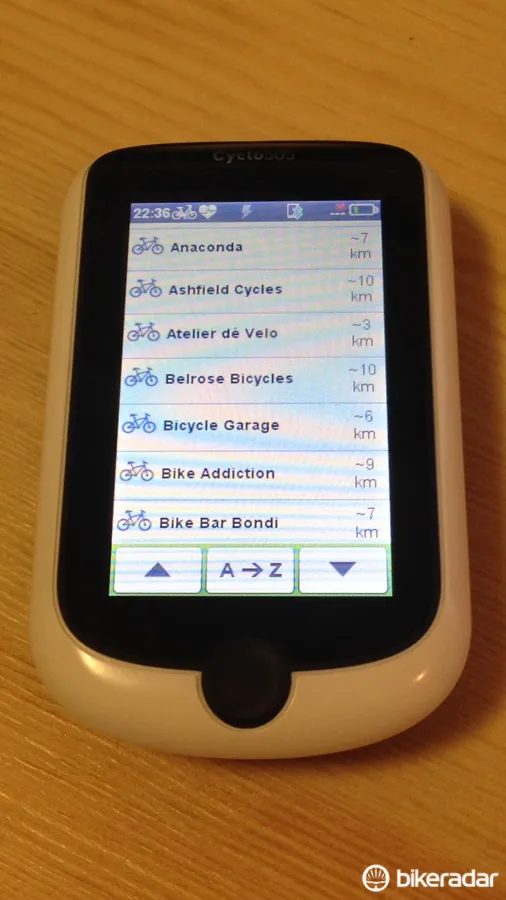The Magellan Cyclo 505 represents the next generation of cycle computers. It has ANT+, WiFi and Bluetooth 4.0 compatibility and is capable of communicating with your phone, home computer and even your gears. We tested this new colour touchscreen, directional mapping computer to see if its competitive price is enough to compete with the new Garmin 1000.
At 129g, the Cyclo 505 isn’t an especially light unit, nor is it compact, measuring 103mm long and 61mm wide. Its size is comparable to that of the Garmin 1000 – it's a little shorter, but a bit deeper. For comparison, the Garmin weighs 115g.
The unit is controlled in a similar way to an iPhone. It has a single home button at the bottom, and all the other features are controlled through the colour touch screen, so using it should feel intuitive to most current smart-phone users. The homescreen features six main panels and although effective, the block colours used are a bit childish and wouldn’t look out of place on a kids' toy.
During our testing, Magellan released updated software that gave a whole new life to the unit. This firmware update opened our eyes to its potential, proving that the hardware is only limited by what the software developers offer.
Magellan Cyclo 505 navigation
The Cyclo 505 comes loaded with Australian and New Zealand maps, and it's easy to set up the unit's directional mapping – just enter the destination, or point to a spot on the map and go, just like with a car GPS. This isn’t surprising given that Magellan and Navman GPS come under the same banner company. With audible ‘beeps’ to alert of upcoming turns and on-screen directions, it’s easy to follow the set track too.
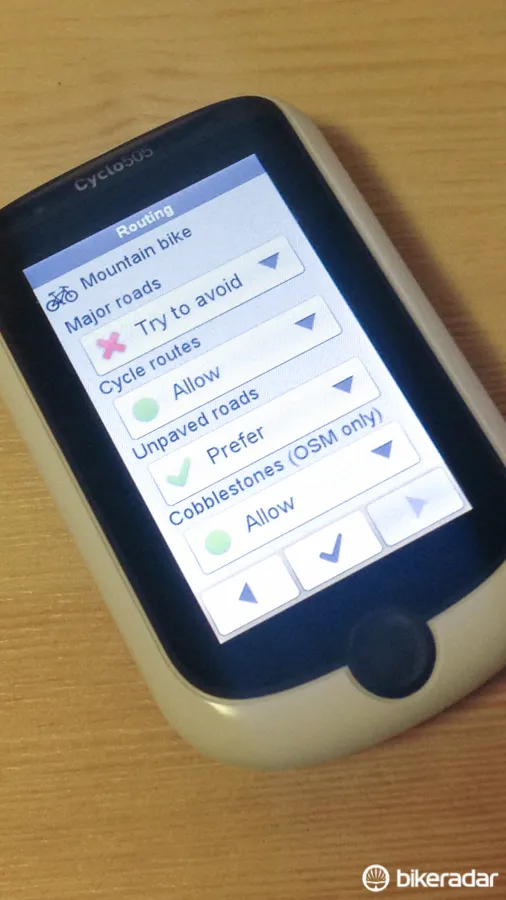
Selecting your desired path type will ensure you're not taken off-road when you're on your road bike, or onto major roads when you're out on your trail bike
You can decide what type of roads, paths or trails you’d like to be directed onto, depending on your desired ride style or bike. This can then be saved for future individual bike profiles, so your ride routes will vary whether riding your road, urban or mountain bike.
We followed the GPS through the centre of Sydney’s suburbia. There were a few moments when the GPS would recommend illegal right-hand turns or unusually hilly routes, but it managed to avoid main roads, took us on a few cycle specific back paths and got us there in the end.

Some examples of the Australian 'Where to Ride' guided options. The distances on the right show the current distance from the ride start
In Australia, the Magellan Cyclo 500 series is pre-loaded with a list of popular ‘Where To Ride’ guided rides, from Bicycling Australia’s popular guide book series. These include both road and off-road rides of varying abilities. The Cyclo gives step-by-step directions as you roll along the route. You don't get spoken directions through the device, but you can get them with the addition of a compatible Android phone and a pair of Bluetooth headphones.
Perhaps the biggest benefit of the directional mapping is being able to follow a route that you’ve found online or been given by a friend and saved to the 4gb internal memory. This isn’t a new concept, but the Cyclo 505 handles the task very well and will redirect if you take a wrong turn. Rides can also be shared wirelessly from Cyclo unit to Cyclo unit, although we didn’t get a chance to test this feature.
An added neat feature is the ability to turn the GPS to ‘car mode’, which is perfect if you’re driving and all you’ve got is your bicycle GPS.
If you don’t know where to ride and you don't fancy the preloaded ‘Where to Ride’ options, there is a ‘surprise me’ feature, in which the Cyclo creates a loop ride based on your current location and desired distance or ride-time. Some of the recommendations were a little odd, but it’s a handy feature if you’re in an unfamiliar area and just want to go for a pedal.
Magellan Cyclo 505 connectivity
You need to make sure you get your settings right, otherwise you’ll be constantly interrupted by other cyclists’ ANT+ signals, traffic light pauses, screen locking and even incoming text alerts. Eventually we got the settings sorted, and once we had we could enjoy our ride without having to worry about accepting commands on the screen.

Call and text alerts is a handy feature
The mobile phone compatibility is certainly one of the biggest advances in cycling GPS units, and the Cyclo 500 series does a decent job. It offers both Android and Apple compatibility, so we could receive text alerts, answer or decline incoming phone calls and even control our music from the touch screen with our phone safely in our pocket or pack.
Shimano Di2 compatibility is a more-recently added feature, and means the unit can now communicate with gears to let you know your battery life and gear choice, as well as recording this information for use later on. It’s probably little more than a gimmick for many (including current Di2 users), but some may find the information useful.
Magellan Cyclo 505 training
The Magellan’s target market isn’t professional athletes, so it currently doesn’t feature such advanced features as separate leg power output. However, it can still be used as a strong training tool, and can even control certain electronic indoor trainers. Power meter compatibility was recently upgraded to fit with most common brands including SRM, Stages, Powertap and Quarq. Testing the unit with Stages, we found it read accurately and could be used on either the ANT+ or Bluetooth band.

MagellanCyclo.com is simple to use, but won't work with either Firefox or Google Chrome
Once back from a ride or workout, you can use the WiFi compatibility to upload your ride data to MagellanCyclo.com. This free web-based software works on both Mac and PC, although browser compatibility is currently limited to Internet Explorer and Safari.
On first connection, we had to register the device by plugging it into the computer, but after this the WiFi connectivity worked exactly as advertised, only requiring a simple push of the respective button. For those using Training Peaks, you'll be keen to know that its simple to share your data with the site. You can also auto-sync your MagellanCyclo account with Strava for near-automatic uploads.
Magellan Cyclo 505 unit and accessories
The unit itself features an IPX7 water-resistance rating, so it can withstand heavy showers or even a quick river crossing without concern. There's a built-in rubber screen protector, which is a nice touch.
Booting up the device is acceptably fast, but approximately 15 seconds longer than the Garmin 1000.
The Cyclo 505 has a claimed battery life of 12 hours, but when running mapping with Bluetooth connectivity, we weren’t able to get anywhere near that. Even when we used the computer as a training tool without mapping, we found the battery life disappeared quicker than the claimed time. It's charged via an included mini-USB cable (and a wall-socket is included).
The unit by itself (AU$399) will show speed data via the GPS signal, however a separate speed sensor will always be more accurate. The 505HC model (AU$479) we tested includes both an ANT+ heart rate monitor and speed/cadence sensor, the same as what came with the Magellan Cyclo 105HC tested previously. The heart rate strap features a soft, flexible strap that's held together by the sensor with snap-lock buttons. The speed/cadence sensor is accurate and reliable but far from pretty – we feel it’s time Magellan updated this to a cleaner, one-piece unit.
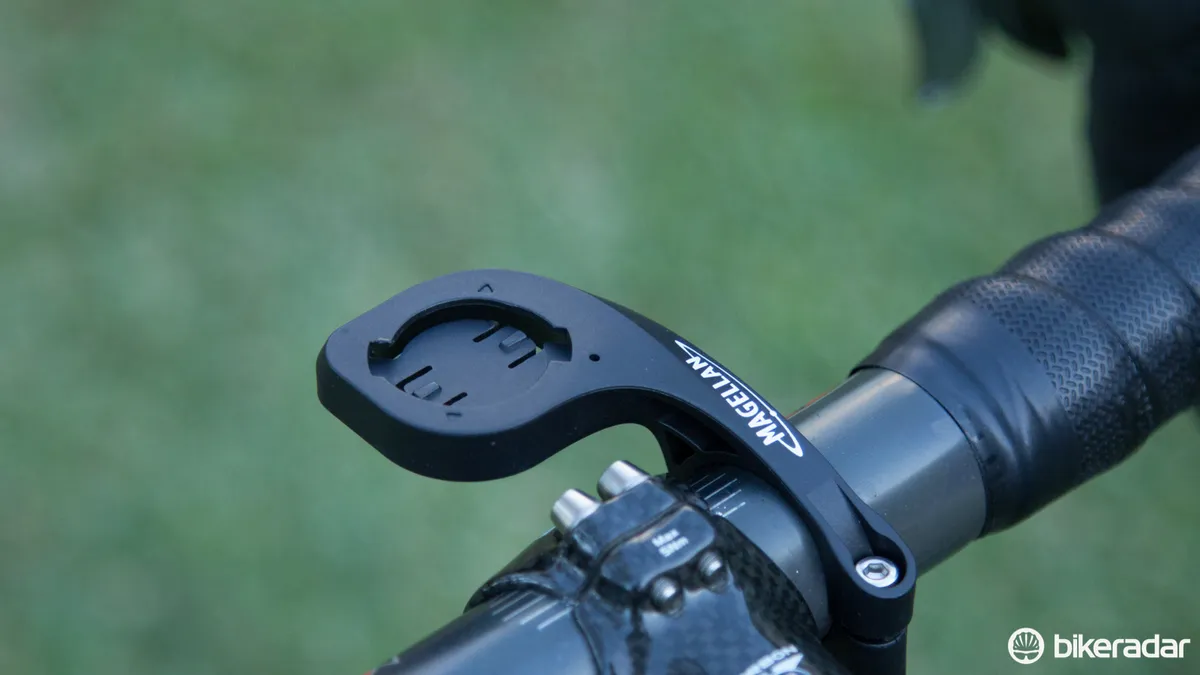
The Out-in-front mount is a great addition the previous standard mount
Also included in the box are two mounts, including a standard stem/handlebar mount which attaches with zipties and the new Out-in-front mount which places the unit in a central position, forward of the stem. While the plastic Out-in-front mount is worthy of the Cyclo unit, the ziptie mount seems a bit weak compared to the easily reusable O-ring system of Garmin.
The Magellan has a similar quarter-turn mount system to Garmin and so it’s possible (although not ideal) to use the vast array of mounts designed for Garmin to hold the Magellan.
The Cyclo 505 is a great unit that will suit a broad range of both on-road and off-road users. It offers enough power meter, heart rate and interval training features to be an effective training tool, yet its mapping functionality will also be appreciated by cyclists who like to explore.
The battery life and overall weight are perhaps its greatest weaknesses, but considering it costs roughly AU$320 less than the comparable Garmin 1000 Bundle, there’s going to be more than a few people who find the Cyclo 505 the better deal.
